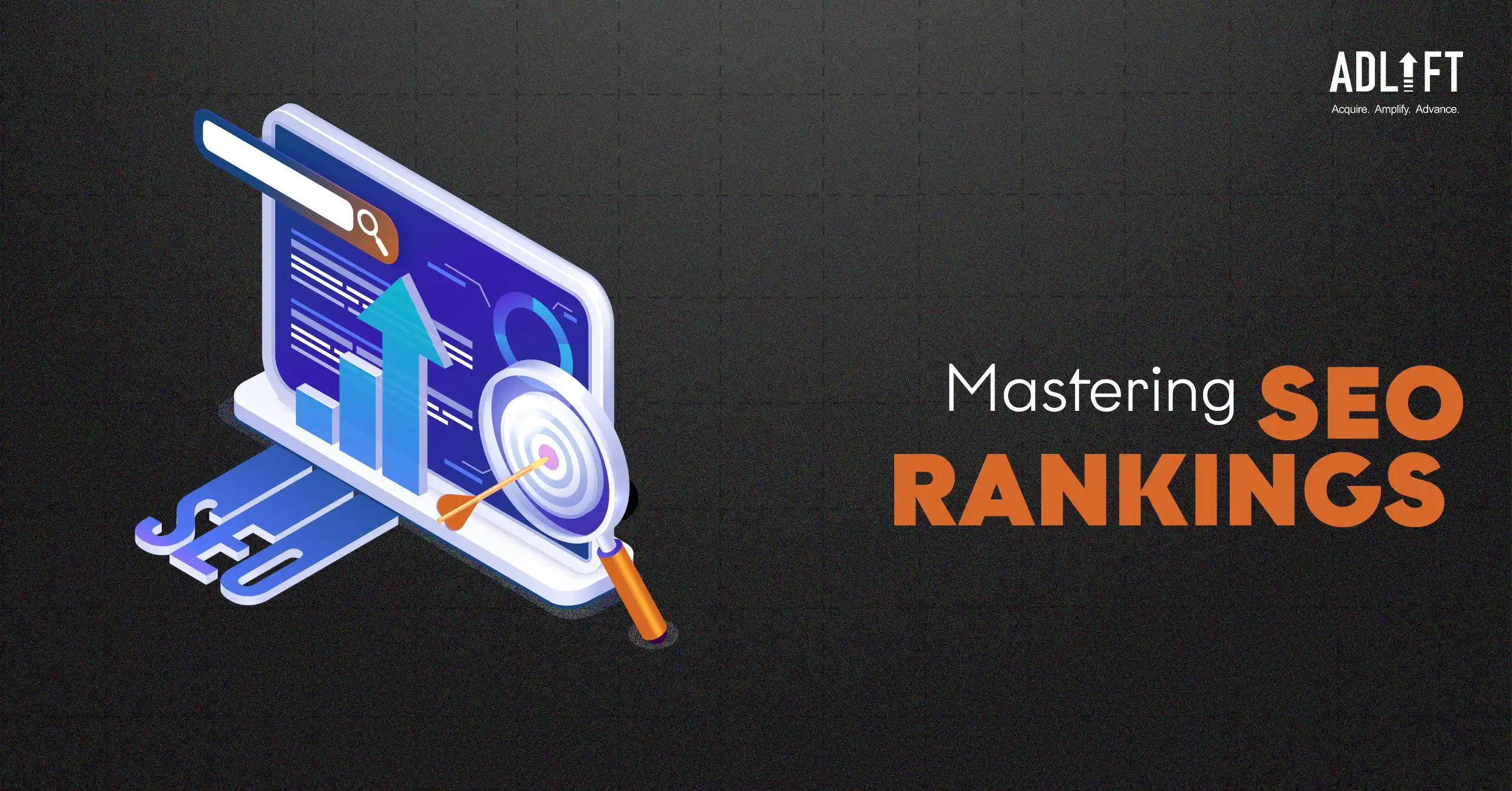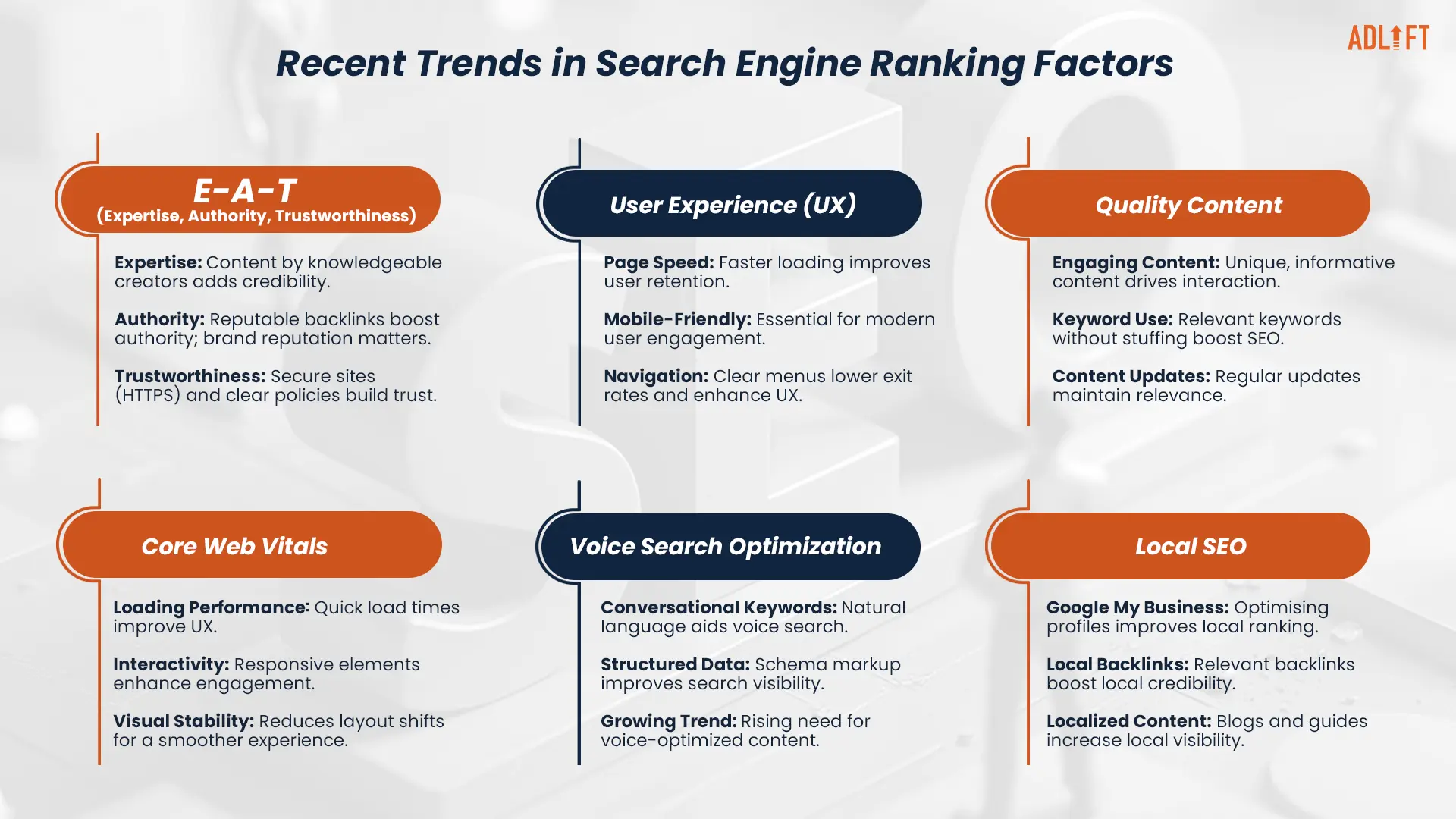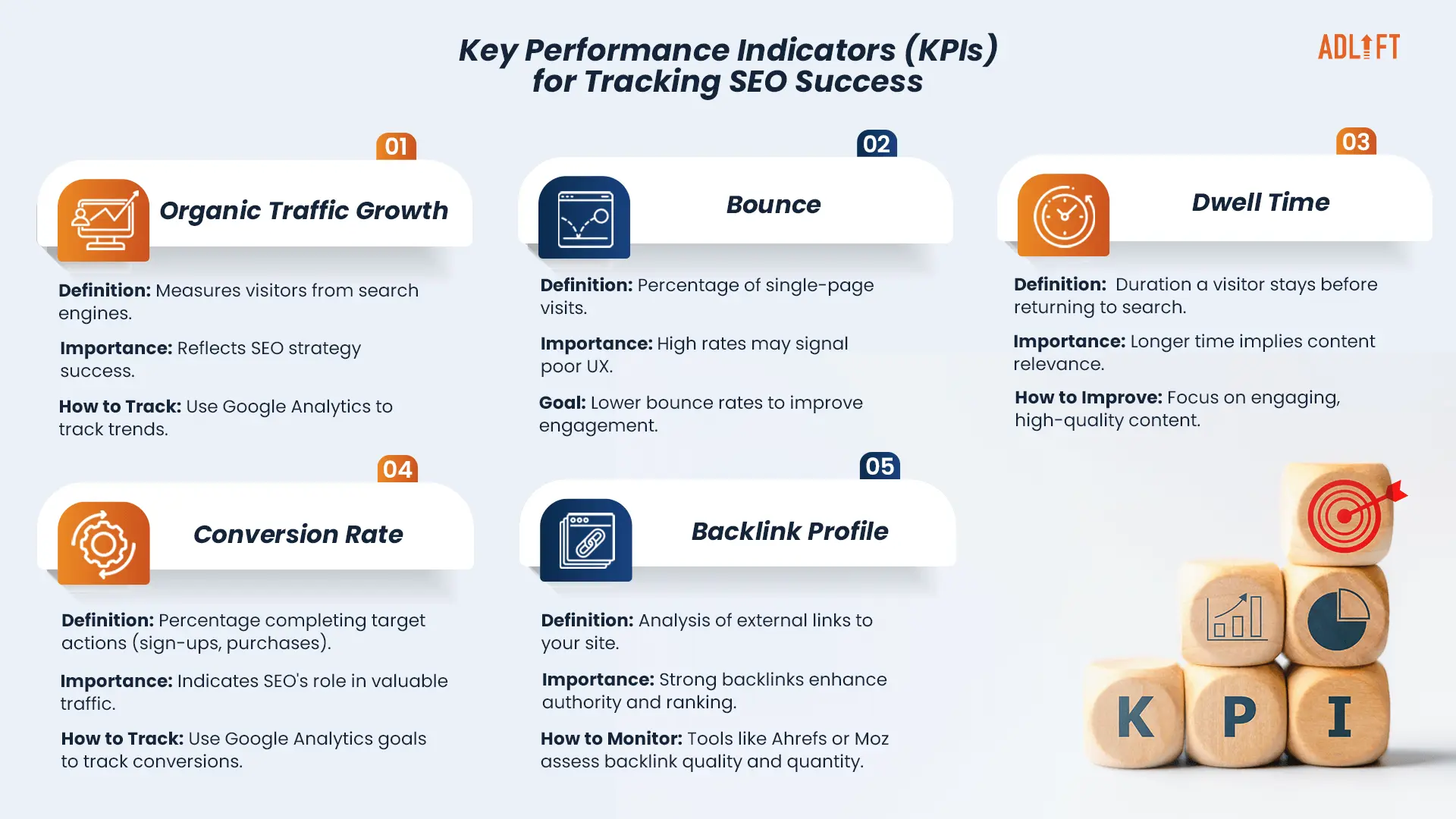SEO Ranking Explained: Proven Techniques to Enhance Your Website’s Traffic

Google’s reach in the digital market is unbeatable. A recent Statista report shows that Google controls 95.32% of mobile searches and 81.95% of desktop searches globally. These figures reveal just how influential Google is in shaping online search behavior, making it the platform of choice for businesses looking to capture online traffic and potential customers.
Given Google’s dominance, it’s no surprise that SEO ranking has become crucial for any website’s success. Understanding and applying the right Google ranking factors is key to improving your site’s visibility in search results. Whether it’s optimizing for keywords or ensuring a seamless user experience, the right approach to ranking factors can dramatically increase your traffic. This blog will delve into these critical search engine ranking factors, guiding you on how to optimize your site to perform well on Google.
In this blog, we’ll discuss the most important factors that influence your SEO ranking and offer practical tips for improving your website’s performance. You’ll also learn about on-page and off-page SEO, as well as strategies for enhancing technical SEO and user experience to boost your traffic.
What is SEO Ranking?
SEO ranking (Search Engine Optimization ranking) refers to the position a webpage holds in search engine results pages (SERPs) for specific keywords or queries. The better a page ranks in search results, the greater its visibility becomes. Since less than 1% of users venture to the second page of search results—only 0.44% of Google search users click on second-page results—your website should rank on the first page for relevant keywords. This visibility can drive significant organic traffic to your site.
When a user looks for information on Google, the search engine utilizes complex algorithms to assess and rank web pages based on various SEO ranking factors. These factors include the content quality, the presence of backlinks, user experience, and site structure. To succeed, your site must meet specific Google ranking factors that signal relevance and authority for a given search query.
For example, if you search for “best gaming chairs,” the first few results may be paid ads, but the top organic result will likely have the highest SEO ranking. This is because Google has determined that this page is the most relevant based on its ranking factors. High-ranking pages in search engine results will always receive more clicks, making their search engine ranking a vital element for online success.
Google’s algorithm evaluates over 210 known ranking factors to determine where a webpage appears in the SERPs. These Google ranking factors include content, page speed, mobile compatibility, and backlink relevance to the search query. Optimizing your website according to these SEO ranking factors increases the likelihood of ranking on the first page, leading to greater visibility, traffic, and conversions.
Key SEO Ranking Factors
Understanding the key SEO ranking factors is essential for enhancing your website and increasing its visibility in search engine results. This section covers the crucial elements that contribute to effective SEO strategies.
Understanding and optimizing for key SEO ranking factors is important for enhancing your website’s performance and improving its visibility in search engine results. Here’s a comprehensive look at the major elements that contribute to an effective SEO strategy.
On-Page SEO Factors
On-page SEO focuses on optimizing individual pages to rank higher and earn more relevant traffic. Key elements include:
Keyword Optimization: Strategically using relevant keywords, such as “SEO ranking” and “SEO ranking factors,” throughout your content, titles, and meta descriptions to improve discoverability.
Meta Tags: Well-crafted meta titles and descriptions help search engines understand your content’s context and relevance, potentially improving click-through rates.
Header Tags: Structuring content with H1, H2, and H3 tags not only enhances readability but also assists search engines in indexing your pages.
Internal Linking: Linking between webpages on your website enhances navigation and distributes page authority, supporting better search engine visibility.
Content Quality: Engaging, well-researched, and relevant content is essential to satisfy user intent and encourage longer visit durations.
Optimizing these on-page factors results in informative, relevant content that boosts your SEO ranking.
Off-Page SEO Factors
Off-page SEO involves strategies that help build your site’s authority and credibility through external signals. Key factors include:
Backlinks: High-quality backlinks from reputable sources act as endorsements, indicating to all the search engines that your content is relatable.
Social Signals: While social media activity doesn’t directly impact rankings, likes, shares, and comments can increase visibility, leading to more backlinks and enhancing SEO indirectly.
Brand Mentions: Positive mentions across various online platforms contribute to brand authority and indirectly support higher rankings.
Effective off-page strategies help establish your site’s reputation and perceived value among users and search engines.
Technical SEO Factors
Technical SEO facilitates better crawling, indexing, and understanding of your website by search engines. Important technical factors include:
Site Speed: Fast-loading pages reduce bounce rates and improve user experience, both crucial for higher rankings. Tools like Google PageSpeed Insights can help identify areas for improvement.
Mobile Optimization: With Google’s mobile-first indexing, a responsive design is necessary for high search engine rankings.
Crawlability: A well-optimized sitemap and robots.txt file ensure search engines can access all your pages, facilitating effective crawling.
Structured Data: Schema markup helps the search engines better understand your content’s context, improving visibility in search results.
SSL Certificate (HTTPS): Websites with HTTPS encryption provide a secure browsing experience, enhancing user trust and earning a slight ranking advantage.
Focusing on these technical aspects is essential for achieving and maintaining strong SEO performance.
User Experience (UX) Factors
User experience has become a crucial element of SEO. Key metrics include:
Bounce Rate: A high bounce rate might indicate content relevancy issues. Engaging, valuable content helps retain visitors.
Dwell Time: It means total time a user spends on a page. Longer dwell times suggest that users find your content useful, which can positively influence rankings.
Mobile-Friendly Design: With a majority of searches occurring on mobile, a responsive design is critical for a positive user experience.
Page Layout: An organized, visually appealing layout without excessive ads improves usability and encourages longer sessions.
Content Freshness
Regularly updating your content signals search engines that your site is active and relevant.
Timely Updates: In fields like technology and news, updating older content with fresh insights can help maintain relevance.
Content Relevance: For topics that don’t change often, having foundational evergreen content can serve well in attracting consistent traffic over time.
Domain Factors
Domain-related factors can also play a role in SEO, although their influence may vary:
Domain Age: Older domains may have a slight edge, but quality content and relevant backlinks remain more important.
Domain Authority: Search engines consider a site’s credibility based on factors like backlinks, traffic, and overall site trustworthiness.
Keyword in Domain: Although not as influential as before, having a relevant keyword in the domain can still signal relevance to search engines.
Schema Markup
Schema markup, or structured data, offers additional information to search engines, allowing them to generate rich snippets in search results. This can improve click-through rates by making your results more visually appealing.
Content Publishing Consistency
Frequent content publication demonstrates to search engines that your website is active and engaged with its users.
Posting Schedule: Maintaining a regular posting schedule signals reliability to both search engines and visitors.
Quality Over Quantity: Consistent, valuable content is more impactful than frequent, low-quality posts.
By prioritizing these user-centric elements, you can create a better experience for visitors, directly influencing your search engine performance.
Google’s Core Algorithm Updates and Ranking Factors
Google has continually refined its algorithms to improve search results and enhance user experience. Key updates have significantly influenced SEO ranking and ranking factors. Here’s a closer look at some of the most impactful updates:
Panda (2011):
The Panda update marked a pivotal shift in how Google assessed content quality. Its primary goal was to reduce the ranking of low-quality websites filled with duplicate or thin content. By giving web pages a “quality score,” Panda penalized sites that failed to meet its standards, thereby prioritizing high-quality, original content. This focus on content quality directly affected SEO ranking factors, pushing website owners to produce valuable, user-focused content.
Penguin (2012):
The Penguin update aimed to combat manipulative link-building practices. Websites utilizing spammy backlinks or over-optimized anchor text faced penalties, which significantly impacted their Google ranking factors. This update emphasized the need for a natural, organic link profile, making it clear that quality over quantity is essential in backlink strategies. As a result, website owners began prioritizing genuine relationships and quality content to earn backlinks.
Hummingbird (2013):
Hummingbird represented a complete overhaul of Google’s algorithm. It was designed to understand better the context of search queries rather than just the individual keywords. This change enabled Google to deliver more relevant results based on user intent. As such, search engine ranking factors evolved, with an increased emphasis on the relevance of content to the user’s search query. This update encouraged SEO practitioners to optimize for topic clusters and semantic search rather than merely focusing on specific keywords.
BERT (2019):
BERT (Bidirectional Encoder Representations from Transformers) marked another significant advancement in Google’s understanding of natural language. This update allowed Google to interpret search queries and webpage content in a more human-like manner, enhancing the algorithm’s ability to understand nuances in language. With BERT, the focus shifted toward understanding context, meaning that pages could rank even if they didn’t contain exact keywords. This change has profound implications for content creation, pushing for more conversational and contextually rich writing.
Over the years, these core algorithm updates have collectively transformed SEO ranking factors. Each update has introduced new considerations for website optimization, emphasizing quality content, natural linking, and user intent. Here’s how these changes have shaped SEO practices:
E-E-A-T Framework:
Recent trends highlight the importance of E-E-A-T—Experience, Expertise, Authoritativeness, and Trustworthiness. This framework is crucial for evaluating content quality, especially for “Your Money or Your Life” (YMYL) topics that can significantly impact users’ well-being, such as health and finance.
Experience: First-hand experience with a subject enhances the content’s credibility. For example, product reviews are more reliable when written by someone who has actually used the product.
Expertise refers to the content creator’s knowledge and skills. High-level expertise in a specific field increases the likelihood that users will trust the content and, consequently, Google will rank it higher.
Authoritativeness: A website’s authority is often determined by its backlink profile. Sites with numerous high-quality backlinks are viewed as more authoritative, which positively influences their SEO ranking.
Trustworthiness: A website must demonstrate reliability through secure connections (HTTPS), accurate information, and a solid reputation. Google wants to protect users from harm by ensuring that trustworthy sources are prioritized in search results.
With these trends continuously shifting, staying informed about core algorithm updates and their implications on google ranking factors will be essential for any SEO strategy. By aligning content and SEO practices with these changes, website owners can significantly enhance their visibility and drive more organic traffic.
Proven Techniques to Boost Your SEO Ranking
Focusing on a blend of key strategies is essential to elevating your website’s SEO ranking and driving more organic traffic. Below are actionable tips that target critical SEO ranking factors and help improve your website’s visibility.
Content Creation and Optimization
Creating and optimizing high-quality content is the foundation of improving SEO ranking factors. Content that answers user intent is well-researched, and is rich in relevant keywords can significantly impact your search engine ranking factors. Here’s how to approach content effectively:
Keyword Research:
Use expert tools such as Google Keyword Planner to recognize the most relevant, high-traffic keywords for your position. These keywords should align with google ranking factors, particularly around user intent. To cover a wide scope of search queries, incorporate long-tail keywords. These are more specific search phrases that often convert better because they match the user’s precise needs. Additionally, integrating LSI (Latent Semantic Indexing) keywords helps Google understand the context of your content. These are semantically related keywords that enrich the depth and relevance of your pages.
Quality Over Quantity:
Google’s algorithms prioritize high-quality, informative content over keyword-stuffed, low-value pages. Emphasize creating well-structured, engaging, and helpful content that answers your audience’s questions comprehensively. Doing this ensures you address SEO ranking factors like dwell time and bounce rate, both of which signal to Google the usefulness of your content.
Link Building Strategies
Backlinks remain a crucial element in google ranking factors. When authoritative websites link back to your pages, it shows trust and relevance to search engines, improving your site’s authority.
Earning High-Quality Backlinks:
Focus on strategies that naturally encourage others to link back to you. For instance, guest blogging on high-authority sites in your industry helps you gain exposure and credible backlinks. Outreach strategies—where you pitch your content to website owners or influencers—can also result in valuable links. Additionally, creating shareable content like infographics, data-driven articles, or engaging videos makes it more likely others will connect to your content as a resource.
Avoid Black-Hat Tactics:
While building backlinks, avoid manipulative or spammy techniques like buying links or engaging in link farms. These practices violate Google’s guidelines and can severely damage your search engine ranking factors through penalties.
Improving Website Speed and Performance
Google has made it clear that website speed is an essential ranking factor. A site that loads slowly often leads to elevated bounce rates, negatively affecting user experience and, consequently, your SEO ranking. Use the following methods to ensure your site runs smoothly:
Optimize with Tools:
You can use tools like GTmetrix to assess your website’s performance. These platforms provide detailed reports and actionable tips for enhancing your site’s speed and overall performance. A well-optimized site not only improves the user experience but also ranks better in Google’s algorithms.
Best Practices:
Optimizing Images: Compress and resize images to lower loading times without sacrificing quality.
Caching: Implement browser caching so returning visitors don’t have to load your entire site from scratch.
Content Delivery Network (CDN): Use a CDN to ensure faster content delivery, especially for users geographically far from your server. A CDN stores copies of your content across various locations, providing quicker access based on the user’s location.
Mobile Optimization and Responsive Design
With the rise of mobile browsing, Google’s shift to mobile-first indexing highlights the need for a mobile-optimized website. This is a crucial Google ranking factor, as websites that aren’t mobile-optimized risk losing traffic and rankings.
Mobile-First Approach:
Ensure your website follows a mobile-first approach by designing with mobile users in mind. This means that content should be easily navigable, load quickly, and display correctly on smartphones and tablets. Google’s Mobile-Friendly Test is a tool to check if your site meets the mobile optimization requirements.
Responsive Design:
Incorporating a responsive design ensures that your site adjusts its layout and features to fit according to the screen size on any device. This adaptability improves the overall user experience, which is an important factor in how Google ranks sites.
Optimizing for Voice Search and AI
With advancements in AI and the increasing use of voice assistants like Google Assistant, optimizing for voice search has become an essential element in SEO. Voice queries are more conversational and often longer, which means your content must reflect this shift to maintain strong SEO ranking factors.
Voice Search Optimization:
People tend to use more natural language when performing voice searches, asking questions like “Where can I find the best coffee near me?” rather than typing keywords like “best coffee shop.” Optimize for these conversational queries by creating content that answers commonly asked questions. This also helps boost your local SEO, as many voice searches are location-based.
Focus on Featured Snippets:
Featured snippets—quick answers that appear at the top of search results—are often the responses used in voice searches. Structuring your content to address specific questions clearly and concisely increases the chances of your content being selected as a featured snippet, further boosting your search engine ranking factors.
Applying these proven techniques can significantly improve your website’s SEO ranking. Whether it’s content optimization, link building, site performance, or mobile-first strategies, addressing these core areas will help you stay ahead of the competition and meet evolving Google ranking factors.
Measuring SEO Success: Metrics That Matter
To guarantee the success of your SEO strategies, it’s crucial to measure success using key performance indicators (KPIs). These metrics provide insights into how well your website is performing in relation to SEO ranking factors.
Organic Traffic Growth
One of SEO’s primary goals is to increase organic traffic, which refers to visitors coming to your website through non-paid search results. Monitoring this metric helps you determine how effectively your SEO strategy is working. An upward trend in organic traffic shows that your website is ranking at the top in search engine results. Various ranking factors influence this positive outcome.
Tracking the increase in organic traffic over time also provides a clearer picture of how changes in your on-page SEO, content strategy, and technical optimization are impacting visibility. Google Analytics and other SEO tools make it easy to monitor this metric and correlate it with specific SEO ranking factors such as keyword optimization and content updates.
Bounce Rate and Dwell Time
The bounce rate refers to the proportion of users who leave your site after only visiting the homepage, while dwell time refers to how long a user spends on your website. Both of these metrics are vital to search engine ranking factors because they indicate user engagement. A high bounce rate might reflect to the search engines that your content lacks relevance or value to visitors, which could negatively impact your SEO ranking.
On the other hand, longer dwell times suggest that users find your content helpful and creative, which is likely to boost your website’s SEO ranking. Improving these metrics involves optimizing user experience through high-quality content, intuitive site navigation, and fast loading times—key SEO ranking factors that contribute to better search engine rankings.
Conversion Rate
While organic traffic is essential, conversions—whether they are sales, sign-ups, or any other user action—are the ultimate goal of any SEO strategy. Conversion rate is also known as the percentage of visitors who take a desired action after arriving at your site. A high conversion rate signals to search engines that your website is offering value to users, which can positively influence your SEO ranking.
Optimizing for conversion involves aligning your SEO strategy with user intent. This means using the right keywords, including SEO ranking factors, to attract visitors who are more likely to convert.
Backlink Profile
Backlinks, or inbound links from other sites, remain one of the most important Google ranking factors. A strong backlink profile—consisting of high-quality, relevant links—can dramatically improve your website’s SEO ranking.
Tracking the number and quality of backlinks makes you understand how well your off-page SEO efforts are performing. Tools like Ahrefs and Moz allow you to check your backlink profile and ensure that your link-building strategies align with key SEO ranking factors.
Page Load Speed and Mobile Optimization
These are critical ranking factors that impact both user experience and SEO ranking. If your site takes too long to load or isn’t optimized for mobile devices, users are likely to leave, which results in a higher bounce rate and lower dwell time.
Tools like Google PageSpeed Insights provide insights into how your website performs in terms of factors like speed or mobile-friendliness. By enhancing these technical SEO factors, you not only improve user experience but also boost your SEO ranking.
Keyword Rankings
Finally, monitoring how well your target keywords are ranking in search engine results is a direct way to measure your SEO success. This involves tracking your progress for specific keywords, including SEO ranking factors, across various pages. Tools like SEMrush or Google Search Console help you keep track of keyword rankings and adjust your strategy as needed.
By consistently measuring these KPIs, you gain a comprehensive understanding of your website’s performance. This helps you evaluate how effectively it is ranking in terms of SEO and search engine ranking factors.
Common SEO Mistakes to Avoid
Achieving a high SEO ranking requires a strategic approach, but some common mistakes can derail your efforts. Understanding and avoiding these errors is essential to improving your website’s visibility and performance. Let’s explore some of the most prevalent mistakes and their impact on SEO ranking factors, including Google ranking factors and other search engine ranking factors.
Keyword Stuffing
One of the most outdated and damaging practices is keyword stuffing. This means overloading your content with keywords in an unnatural way. This tactic might have worked in the past, but search engines like Google have evolved to prioritize user experience. Modern Google ranking factors favor content that naturally incorporates relevant keywords, not forced repetition. Overusing keywords can not only confuse readers but also lead to penalties, which ultimately harm your SEO ranking. To avoid this, focus on creating meaningful, high-quality content that includes keywords naturally.
Duplicate Content
Another common mistake is publishing duplicate content, which happens when the same or very similar content appears on various pages of your site or across different websites. Duplicate content confuses search engines about which version to prioritize, which can negatively impact your search engine ranking factors. Google’s algorithms prefer unique, valuable content that adds something new to the conversation. If you inadvertently create duplicate content (for instance, through similar product pages), using canonical tags can help resolve this issue and improve your SEO ranking factors.
Neglecting Technical SEO
Elements such as site speed, crawlability, mobile optimization, and structured data all play a critical role in Google ranking factors. Ignoring these ranking factors can result in slow load times, poor mobile performance, and difficulties for search engines in understanding your content. If technical SEO is addressed, even the best content will be able to rank highly.
Ignoring Mobile Optimization
The majority of global internet traffic, over half, comes from smartphones. Failing to optimize for mobile can severely damage your SEO. Google’s mobile-first indexing prioritizes the mobile version of your site and is prioritized in search rankings. Responsiveness of mobile, fast load times, and easy navigation on smaller screens are now vital Google ranking factors. Websites that ignore mobile optimization will likely see a drop in their SEO ranking.
Focusing Solely on Desktop Optimization
A related mistake is focusing all your SEO efforts on the desktop version of your website. While a well-optimized desktop site is important, overlooking mobile optimization can hurt your SEO ranking factors significantly. With Google’s mobile-first indexing, websites are ranked primarily based on how they perform on mobile. It’s critical to provide an equally strong experience for mobile users to satisfy search engine ranking factors.
Overlooking User Experience (UX)
The user experience is a growing factor in SEO, and ignoring it can lower your SEO ranking. Google and other search engines evaluate metrics like bounce rate, dwell time, and page speed to gauge how well users engage with your site. Poor navigation, cluttered layouts, or slow load times may cause an increase in bounce rates, sending notifying search engines that your website isn’t providing value. This can result in a drop in Google ranking factors. Enhancing user experience through better design, faster load times, and clear navigation can help improve your ranking factors across the board.
Not Prioritizing High-Quality Backlinks
Despite being a key search engine ranking factor, backlinks are often not given the priority they deserve by many websites. Earning links from high-authority sites signals to Google that your content is trustworthy and valuable. However, relying on low-quality or irrelevant backlinks can hurt your SEO ranking factors. Focus on building organic, relevant backlinks from reputable sites. Guest blogging, influencer collaborations, and high-quality, shareable content are effective strategies to attract the right kind of links that boost your SEO.
Ignoring Content Updates and Freshness
Content freshness is another vital factor in maintaining your SEO ranking. Many websites need to be aware of creating content and then neglecting it for long periods. However, Google favors fresh and regularly updated content as part of its ranking factors. If your site contains outdated or irrelevant information, it may drop in the rankings. Reviewing and updating your existing content regularly ensures that it remains relevant and continues to align with evolving search engine ranking factors.
Misusing Meta Tags and Descriptions
Failing to optimize these tags or using duplicate tags across pages can confuse search engines and diminish your site’s SEO ranking factors. Writing compelling and unique meta tags that include target keywords like SEO ranking can improve click-through rates and overall visibility in search results.
Lack of Internal Linking Strategy
A lack of internal linking or a disorganized approach can confuse search engines and prevent important pages from being properly indexed. Effective internal linking is a key part of SEO ranking factors, and it can also help users navigate your site more easily.
By avoiding these common SEO mistakes, you can enhance your website’s performance and align with critical google ranking factors.
Boost Your SEO Ranking with Proven Strategies and Expert Guidance
Achieving and maintaining a high SEO ranking in this competitive digital landscape requires a solid understanding of the core SEO ranking factors and google ranking factors. From optimizing your on-page content to ensuring a strong backlink profile, these search engine ranking factors play a significant role in determining how your website performs in search results. The key is to stay proactive—consistently refining your content, improving technical SEO, and delivering an outstanding user experience.
But navigating the complexities of SEO doesn’t have to be difficult. That’s where AdLift comes in. Founded in 2009, AdLift has been helping businesses accelerate growth without any hassle. Our mission is simple: to provide individualized, expert search solutions that drive ROI. With a team experienced in SEO, Paid Search, and Analytics, we’re equipped to ensure your brand’s performance thrives.
By partnering with AdLift, you can focus on what you do best—running your business—while we take care of the SEO strategies that will improve your SEO ranking and help you stay ahead of ever-changing Google ranking factors. Let us help you achieve sustainable growth with tailored solutions that deliver real, measurable results.
Ready to take your SEO to the next level? Visit AdLift to guide you to the top!
Sources: https://www.statista.com/statistics/216573/worldwide-market-share-of-search-engines/
https://www.forbes.com/advisor/business/software/seo-statistics/
Categories
Recent Posts
- How do I Verify My Business on Google to Ace Local SEO? March 17, 2025
- The Pros and Cons of Pay For Performance SEO March 17, 2025
- Website Structure for SEO: A Blueprint for Better Rankings March 17, 2025
- Is SEO for Subdomains Hurting your Rankings? Let’s Find Out! March 17, 2025
- Outsourcing SEO: A Cost-effective Solution for Startups to Scale Quickly March 17, 2025
- Keyword Cannibalization: Why It Matters for Your Company and How to Avoid It March 12, 2025
- The Role of SEO Projections in Budget Planning for CMOs March 11, 2025
- SEO for Bing: Unlocking Opportunities for Business Owners and Marketers March 11, 2025
- How to Maintain SEO and Rankings: Your SEO Maintenance Checklist March 7, 2025
- Must-have Enterprise SEO Tools to Boost your Online Presence March 7, 2025
Get
in Touch
Contact AdLift for a 360-degree marketing plan





